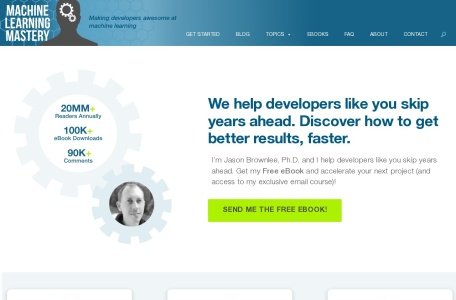
As “machine learning” becomes a core marker of workplace competitiveness, countless learners find themselves stuck in a dilemma: deterred by mathematical formulas when trying to start, and unable to apply theoretical knowledge even after studying. Academic textbooks are filled with matrix derivations, and scattered online videos leave learners unable to write a single line of practical code. However, MachineLearningMastery – founded by seasoned data scientist Jason Brownlee – has become the “practical compass for machine learning” for 2 million global learners, driven by its mission to “turn machine learning from ‘textbook knowledge’ into ‘actionable skills'” and its unique features of “project-driven learning, de-theorization, and lifelong free access.” By 2025, the platform has produced over 1,500 original tutorials, 30+ hands-on courses, and 500+ reproducible code examples, and is even listed as a recommended resource for employee skill development by companies like Microsoft and Amazon. This article unpacks why it stands as the “No.1 practical machine learning platform” by examining its core resources, user cases, and learning logic.
I. Platform Positioning: More Than a “Tutorial Collection” – A Complete ML Implementation Ecosystem
MachineLearningMastery is not a traditional “knowledge popularization platform” but a full-cycle learning ecosystem for “from entry to implementation,” built by Jason Brownlee based on 15 years of industry experience. Jason previously worked in a NASA-affiliated laboratory, leading multiple ML implementation projects such as medical data prediction and industrial equipment fault diagnosis. He clarifies the platform’s positioning on its homepage: “We don’t teach ‘how to derive algorithms’ – we teach ‘how to use algorithms to solve problems in your work.’ After all, companies don’t need people who can recite formulas—they need people who can deliver results.”
The platform’s core competitiveness stems from three differentiated traits:
- Practice-Oriented: All content revolves around “implementable projects,” such as “using Random Forest to predict customer churn” or “using LSTM for product sales forecasting,” rather than simply explaining algorithm principles;
- Low-Barrier Access: Complex mathematics is translated into “everyday analogies” – for example, explaining decision trees with “grocery store product categorization” and feature normalization with “student grade ranking” – making concepts accessible even to learners with weak calculus foundations;
- Open Resources: 90% of tutorials, code examples, and datasets are completely free. Only advanced specialized courses charge reasonable fees (average \(30–\)70 per course), significantly reducing learning costs.
II. Core Resources: Three Content Types Cover All Needs “From Beginner to Advanced”
Platform content is categorized by “learning stage” and “application scenario,” with a clear structure. Learners can quickly find resources matching their skill level, avoiding wasted time on scattered materials.
1. Free Tutorial Library: The “First Stop” for Beginners
As the platform’s “traffic core,” this library hosts over 1,500 original tutorials covering three areas: “tool basics, algorithm practice, and problem-solving.” Each tutorial includes “principle breakdown + complete code + result analysis.” Typical content includes:
- Tool Introduction Series: From “Python basic syntax” to “Pandas data processing” and “Scikit-Learn quick start,” each tutorial features “step-by-step code demonstrations.” For example, Learn to Process Excel Data with Pandas in 10 Minutes uses real business data (e.g., e-commerce sales spreadsheets) to teach readers the full workflow of “data cleaning – filtering – statistics,” which can be directly applied to work after reading;
- Algorithm Practice Series: For mainstream algorithms like decision trees, Random Forest, SVM, and LSTM, each tutorial focuses on a “specific problem.” For instance, Predicting Housing Prices with Random Forest: From Data Preparation to Model Deployment details “how to obtain datasets (recommending Kaggle resources), feature engineering (handling missing values, encoding categorical variables), model training (hyperparameter tuning tips), and result visualization” – even including “how to save models as Pickle files for later use”;
- Problem-Solving Series: Addressing common learner pitfalls (e.g., “how to handle imbalanced data,” “what to do about model overfitting,” “how to select features when there are too many”), content is presented as “problem scenarios + comparison of multiple solutions.” For example, 3 Ways to Handle Imbalanced Data in Classification Tasks: SMOTE, Weighted Loss, Ensemble Sampling provides code examples for each method, helping readers visually compare “which solution works best.”
The highlight of these tutorials is their “no fluff, high practicality.” An internet operations specialist shared: “I used to find Python abstract, but after reading the platform’s User Behavior Analysis with Python, I ran the code with my company’s user data. Not only did I learn the tool, but I also identified 2 previously unnoticed user churn risks – which I directly included in my weekly report.”
2. Hands-On Courses: The “Progression Ladder” for Systematic Skill Building
For learners seeking structured skill development, the platform offers 30+ paid courses, categorized by “learning goals” into “beginner entry,” “specialized skills,” and “industry applications.” Courses are 5–10 hours long (suitable for fragmented learning) and include “exclusive communities, homework feedback, and lifelong updates”:
- Machine Learning for Beginners: From Python to Scikit-Learn: Designed for zero 基础 learners, no math background required. Using life-related projects like “supermarket sales forecasting” and “customer satisfaction classification,” it guides readers to master the core workflow of “data processing – algorithm selection – model evaluation.” An accountant who completed the course optimized their company’s “accounts receivable overdue prediction” model using the taught methods, increasing accuracy by 25%;
- Deep Learning Hands-On: Building Neural Networks with Keras: For learners aiming to enter deep learning, it avoids complex TensorFlow low-level code and focuses on “how to quickly implement models with Keras.” For example, Image Classification with Keras: Cat vs. Dog Recognition breaks down the full process from “dataset download (providing Baidu Cloud links) – image preprocessing (resizing, normalization) – building CNN models (including tuning tips) – model evaluation,” even teaching readers “how to use trained models to recognize photos from their phones”;
- Time Series Forecasting Hands-On: From ARIMA to LSTM: Focusing on high-frequency industry needs (e.g., sales forecasting, equipment fault early warning), it uses real cases like “predicting faults with factory equipment temperature data” and “monthly sales forecasting for a bubble tea shop” to compare the pros and cons of ARIMA, Prophet, and LSTM – helping learners understand “which algorithm to choose for different scenarios.”
A key advantage of these courses is “lifelong updates”: Jason’s team regularly updates content based on tool version iterations (e.g., Scikit-Learn updates, Keras API changes) and new industry needs (e.g., combining traditional ML with large model fine-tuning). One purchase grants permanent access, avoiding “outdated knowledge after learning.”
3. Code & Dataset Library: The “Toolbox” for Project Implementation
The platform curates 500+ reproducible code examples (GitHub repository with over 30,000 stars) and 100+ industry-specific datasets (covering e-commerce, healthcare, manufacturing, etc.), each labeled with “data source, application scenario, and preprocessing methods”:
- Code Examples: Categorized by “task type” (e.g., “classification tasks,” “regression tasks,” “clustering tasks,” “time series tasks”), each example includes “annotated code + screenshot of results + key parameter explanations.” Learners can download them directly to local devices and modify the data for quick application;
- Datasets: Selected to address “practical pain points” – such as “small-sample datasets” (suitable for beginners), “labeled medical imaging datasets” (ideal for computer vision entry), and “industrial datasets with missing values” (great for practicing data cleaning). Some datasets even include “data dictionaries” to help learners understand the business meaning of each field.
A data analyst shared: “When working on a ‘user retention prediction’ project, I couldn’t find a suitable dataset for practice. I downloaded the ‘e-commerce user behavior dataset’ from the platform, followed the supporting code to complete feature engineering, and quickly clarified my approach – delivering the project 3 days ahead of schedule.”
III. Core Advantages: Four Traits That Outperform Competitors
Amid competition from platforms like Coursera and Udemy, MachineLearningMastery attracts 2 million learners thanks to four irreplaceable advantages:
1. “De-Theorized” Teaching: Math No Longer a Barrier
Unlike many platforms that start with formula derivations when teaching algorithms, MachineLearningMastery uses a “learn by doing” logic. For example, when teaching linear regression, it first shows readers how to write 3 lines of Scikit-Learn code to implement “housing price prediction.” After seeing the results, it uses “drawing a straight line to fit scatter points with a ruler” to analogy “finding the optimal solution for linear regression,” and finally briefly explains that “loss function measures how well the line fits.” Learners don’t need to understand calculus derivations, but they do learn “why to tune learning rates” and “how to judge model fitting effectiveness.” This approach allows many “non-technical” learners (e.g., operations, accountants, administrators) to enter machine learning.
2. Industry Perspective: Content Aligned with Workplace Needs
Jason’s team designs courses and tutorials based on “real corporate scenarios.” For example:
- When teaching feature engineering, it emphasizes “how to handle outliers in business data (e.g., negative order amounts)” and “how to convert date fields into valuable features (e.g., ‘is weekend,’ ‘is holiday’)” – issues encountered daily in the workplace, not “ideal data” from textbooks;
- When teaching model evaluation, it covers not only accuracy and recall but also “how to select metrics based on business scenarios” (e.g., “fraud detection” prioritizes high recall to avoid missed cases; “recommendation systems” balance accuracy and coverage) – helping learners develop a “technology serves business” mindset.
An HR manager for an internet company’s algorithm team noted: “When recruiting junior data analysts, we value whether candidates have ‘practical thinking’ – such as whether they’ve handled messy real-world data or know how to adjust models based on business needs. Learners from MachineLearningMastery often outperform new graduates who only studied textbooks in this area.”
3. Sustainable Free Resources: No “Predatory Paid Tactics”
90% of the platform’s core resources (tutorials, code, datasets) are completely free. It only profits from a small number of advanced courses and corporate training – a model that prioritizes “content quality” over “paid conversion”:
- Free tutorials are updated steadily (2–3 per week) with in-depth content. For example, Optimizing Supply Chain Inventory with Machine Learning: From Demand Forecasting to Safety Stock Calculation is nearly 10,000 words long, covering the full workflow of “data preparation – model selection – applying results to business decisions” – matching the depth of paid courses;
- Free code libraries are regularly maintained to adapt to the latest tool versions. For example, after the release of Scikit-Learn 1.3, the team updated all related code examples within a week to ensure learners “can run them directly after download without errors.”
This “sincere” approach has built strong word-of-mouth. Many learners start with free resources and later voluntarily purchase advanced courses, creating a “virtuous cycle.”
4. Community Support: A “Mutual-Aid Network” of 2 Million Learners
While the platform has no dedicated forum, it has formed a three-tier support system: “tutorial comment sections + GitHub discussion boards + WeChat/WhatsApp communities”:
- Tutorial Comment Sections: Thousands of comments under each tutorial allow learners to ask questions (e.g., “Why does this code throw a dimension error?”). Jason’s team or experienced learners reply regularly, and high-frequency questions are compiled into “FAQ documents”;
- GitHub Discussion Boards: The Issues section of the code repository lets learners share “modified code” and “new problems encountered.” For example, someone shared “how to integrate weather data to improve accuracy when using the platform’s LSTM code to predict bubble tea shop sales” – enabling “secondary creation”;
- Exclusive Course Communities: Learners who purchase courses can join WeChat/WhatsApp groups. Jason hosts regular live Q&As (e.g., “Combining traditional ML with large model fine-tuning”) and the communities share “internal referral opportunities” and “latest industry reports.” Some learners even found collaborators through these groups.
IV. Target Audience: Who Should Choose MachineLearningMastery?
The platform is not “one-size-fits-all,” but it offers exceptional value for three groups:
1. Career Changers with Zero ML Experience: Low-Cost Trial, Quick Entry
If you work in non-technical roles (e.g., operations, accounting, administration) and want to switch to data analyst or ML engineer – and meet the prerequisites of “basic computer skills and ability to understand simple English (tool documentation)” – the platform’s free tutorials let you “test the waters at no cost.” First, use Python Basics for Practice and Scikit-Learn Entry to gauge your interest, then decide whether to purchase advanced courses. An administrator shared: “I studied the platform’s free tutorials for 3 months in my spare time, practiced with Excel data to create a ‘department expense forecast,’ and included this in my resume. I successfully got a data analyst offer at an e-commerce company, with a 40% salary increase.”
2. Students: Supplement Practical Experience, Boost Employability
For students majoring in computer science, mathematics, or statistics, the platform helps bridge the gap between “theoretical school teaching and practical workplace needs”:
- Freshmen/Sophomores: Learn Python and Scikit-Learn through free tutorials and participate in school “data analysis competitions”;
- Juniors/Seniors: Take advanced courses (e.g., Deep Learning Hands-On) and use platform datasets for “graduate projects” (e.g., “medical image recognition,” “stock trend prediction”). These projects are more valued by HR than “ideal data experiments” from textbooks. A computer science student used the platform’s “time series forecasting course” to create a “city bike-sharing demand prediction” project, which helped them get interview invitations from ByteDance and Meituan.
3. Industry Professionals: Solve Practical Problems, Upskill
For data analysts, algorithm engineers, and other professionals, the platform is a “desk reference”:
- When facing new tasks (e.g., “first time doing time series forecasting”), check corresponding tutorials to get started quickly;
- When encountering technical issues (e.g., “stagnant model accuracy”), find solutions in comment sections or GitHub;
- When learning new tools (e.g., “switching from Scikit-Learn to TensorFlow”), master them systematically through specialized courses. A data analyst at a financial company shared: “When working on a ‘credit risk prediction’ project, my model accuracy was stuck at 75%. I read the platform’s 5 Methods for Feature Selection, optimized using ‘recursive feature elimination,’ and increased accuracy to 83% – the project passed review smoothly.”
V. Learning Guide: Tips to Avoid Pitfalls and Progression Paths
1. Efficient Learning Tips
- Start with Free Tutorials to Clarify Goals: Don’t buy advanced courses immediately. Spend 1–2 weeks reading 3–5 free tutorials (e.g., Pandas for Data Processing , Machine Learning Entry: Classification with Random Forest) to assess your interest and foundation before making a plan;
- Learn by Doing – Don’t Copy Code: When reading tutorials, write code yourself instead of copying directly. If you encounter errors, first try debugging (e.g., print data shapes, check parameter correctness). Only consult the community if you can’t solve it independently – debugging skills are among the most important in the workplace;
- Learn Driven by “Business Problems”: If you work in e-commerce, focus on “user churn prediction” and “sales forecasting”; if you work in finance, focus on “expense forecasting” and “payment risk assessment.” Learning with specific problems significantly improves efficiency.
2. Pitfall Avoidance Reminders
- Don’t Try to Learn Everything: The platform has many tutorials – don’t aim to “read all content.” Instead, “learn what you need” (e.g., focus on decision trees/Random Forest for classification tasks; focus on linear regression/LSTM for forecasting tasks) to avoid “forgetting what you learned earlier”;
- Don’t Neglect Basic Tools: Many learners rush to study deep learning but lack proficiency in Pandas (Python’s data processing library). Data processing is the foundation of ML – be sure to master the platform’s Pandas Practice Series to avoid frequent roadblocks in later projects;
- Don’t Blindly Trust “Hyperparameter Tuning Secrets”: The platform teaches tuning techniques (e.g., grid search, random search) but emphasizes “tuning must align with business scenarios.” For example, a “fraud detection” model can’t just pursue high accuracy – it must also consider “the cost of missing a fraud case” to avoid fixating on “pure technical metrics.”
3. Progression Paths
- Basic Stage (1–3 Months): Complete Python basics, Pandas data processing, and Scikit-Learn entry tutorials. Be able to independently complete “simple classification/regression projects” (e.g., “Iris dataset classification,” “Boston housing price prediction”);
- Advanced Stage (3–6 Months): Take advanced courses (e.g., Deep Learning Hands-On , Time Series Forecasting), try building models with Keras/TensorFlow, and participate in Kaggle competitions (practice with platform datasets first);
- Implementation Stage (6–12 Months): Create “business-driven projects” based on your industry (e.g., “healthcare: disease risk prediction,” “retail: inventory optimization”), upload projects to GitHub, and build a portfolio for job hunting or promotion.
Conclusion: The “Optimal Solution” for ML Implementation Lies in “Practice”
MachineLearningMastery’s success essentially stems from addressing a core learner pain point: “The goal of learning ML isn’t to understand theory – it’s to solve problems.” It doesn’t pursue “academic depth,” but uses “down-to-earth” content to help ordinary people access ML; it doesn’t rely on “predatory paid tactics,” but wins the trust of 2 million learners with “sincere free resources.”
For 2025 learners, MachineLearningMastery is more than a “tutorial platform” – it’s a “machine learning implementation toolbox.” Here, you don’t need to understand complex mathematical formulas to learn how to use algorithms to solve work problems; you don’t need to pay high tuition to gain workplace-aligned skills. As Jason writes on the platform’s homepage: “The value of machine learning isn’t in how many algorithms you can memorize—it’s in how much value you can create with them.” From reading your first free tutorial to writing your first line of code, you’re just one “hands-on step” away from becoming a “practice-ready ML learner.”
Relevant Navigation


Introduction to Neural Networks

Microsoft Reading Coach

Fellou

AISEO

ML for Beginners

rabbitOS intern

Aipy

